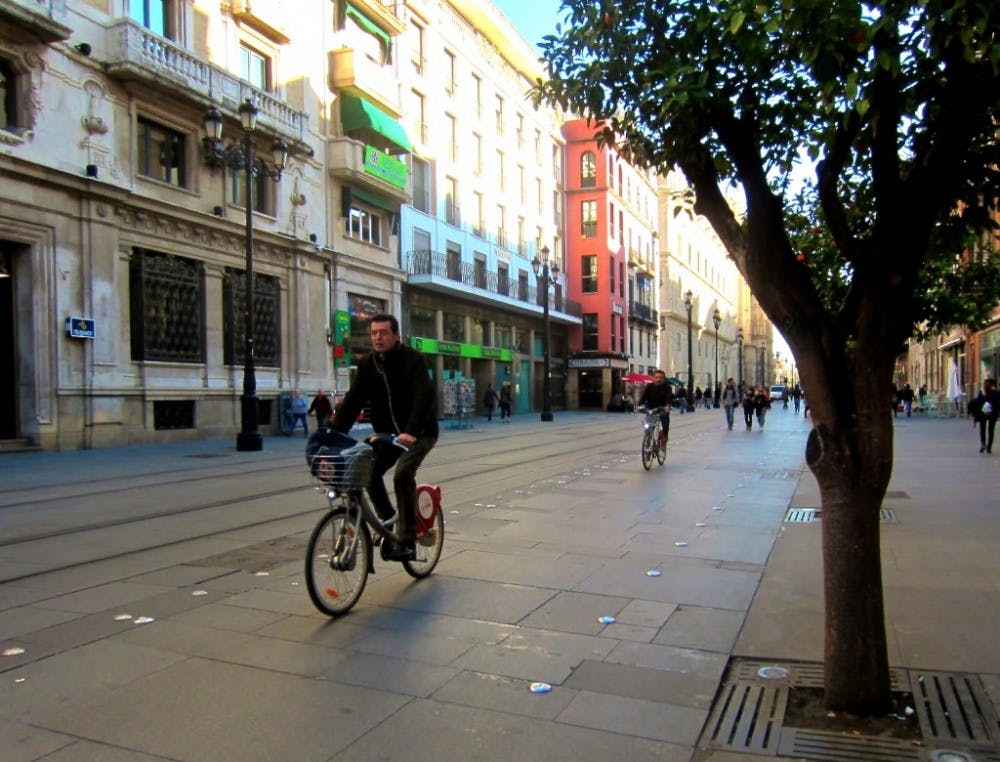SEVILLE, SPAIN – As the capital of Andalucia and the fourth largest city in Spain, Seville is turning heads with an impressive public transportation system. Where you would expect a city crowded with cars and the incessant honking of horns, the quiet hum of buses and trams fills the air. The previous mayor of Seville, Alfredo Sanchez Monteseirin, made extensive changes to improve public transportation during his time in office. These changes included creating bicycle lanes, redirecting traffic to allow for expanded pedestrian zones in the historic area, completing the metro-line project and creating “El Tranvia,” the tramline that runs through La Avenida de la Constitucion. As a result, the people of Seville are able to walk safely through traffic-free streets of the historic area. While cars are no longer an issue, pedestrians are not the only ones lining the streets. Along with the expanded walkways, bike lanes were constructed for roller skaters, skateboarders and bicyclists. Fines discourage people from walking on these lanes.
After speaking with several Spaniards about these changes, the general consensus was positive. Locals enjoyed the increased accessibility of public transportation and lack of cars and other private vehicles. With cars no longer crowding the streets, traffic is a non-issue and there are fewer toxins in the air. Many individuals had expressed concern about pollution damaging the Seville Cathedral, located along La Avenida de la Constitution. Local residents of Seville agreed the Cathedral benefited from the removal of traffic in the area. The tram has been extremely helpful in cutting back the use of cars, as it is both accessible and affordable. According to metro-sevilla.es, a ticket for unlimited usage is less than five euros. Seville resident Juan Maria said the tram has developed into a useful means of transportation for older residents within the city. “Not only is it safer for them to walk around the area with the tram slowly moving than crazy drivers in the street, it is very user friendly for people of all ages. It’s nice to see the older couples walking around and enjoying the area like they used to,” Maria said. Biking has also grown in popularity, as bikes are easily accessible. Located in numerous spots throughout Seville are the “Sevici” bike racks. At any of the kiosks located throughout the city, a €25 pass allows individuals to use the bikes at their leisure. Bikes picked up from a rack by the river can later be dropped off at a rack across town. After 30 minutes, there will be an additional charge, but the locals explain simply switching bikes allows them to ride another 30 minutes. Apps for smart phones indicate where each Sevici bike rack is located. The bus is another common way of getting around the city. Age is irrelevant, as students and the elderly alike form lengthy lines by the bus stops near Plaza de Duque. The buses use the same ticket system as the tram, making it easy for people living and working in the city to get around on a tight budget. Spain’s economy shows no signs of improvement, so Spaniards aim to cut corners with their budgets. With a 26 percent unemployment rate and layoffs occurring daily, the public transportation system is becoming increasingly popular. Spain’s struggling economy has made the affordability of Seville’s public transportation alluring for local residents. Personal vehicles are rarely found, as buses, bicycles and pedestrians now fill the streets of Seville.


